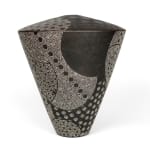KITAMURA Junko 北村純子 b. 1956
Vessel, 2022
Stoneware
H13” x Dia 11.5”
H33x Dia 29.2cm
H33x Dia 29.2cm
With Signed Wood Box
Further images
-
(View a larger image of thumbnail 1
)

-
(View a larger image of thumbnail 2
)

-
(View a larger image of thumbnail 3
)

-
(View a larger image of thumbnail 4
)

-
(View a larger image of thumbnail 5
)

-
(View a larger image of thumbnail 6
)

-
(View a larger image of thumbnail 7
)

-
(View a larger image of thumbnail 8
)

-
(View a larger image of thumbnail 9
)

-
(View a larger image of thumbnail 10
)

-
(View a larger image of thumbnail 11
)

-
(View a larger image of thumbnail 12
)

-
(View a larger image of thumbnail 13
)

KITAMURA Junko (b. 1956): Vertiginous, geometric, and sculptural are words ascribed to Kitamura Junko’s style. Trained under the important Sodeisha pioneer Suzuki Osamu, Kitamura’s sense for abstract, sculptural form shines...
KITAMURA Junko (b. 1956): Vertiginous, geometric, and sculptural are words ascribed to Kitamura Junko’s style. Trained under the important Sodeisha pioneer Suzuki Osamu, Kitamura’s sense for abstract, sculptural form shines through in her functional vessels. She also studied under Kondō Yutaka (1932-83), whose sense for surface pattern is palpable in her work. Her intricate patterns are inspired by Korean Buncheong pottery, which reached its zenith in popularity during the Joseon dynasty. Her work, like Buncheong pottery, features concentric, dotted, impressed surface design inlaid with a viscous white slip. At the same time, it recalls the extensive history of decorative arts in Japan, taking after textile patterns in the intricacy of the linear designs made in a scrolling pattern across the surface of her monochromatic clay. As a woman in the male-dominated ceramic industry in Japan, Kitamura progresses the field forward.
This work is enclosed in its original signed wooden box. Her work is now in the permanent collections of the British Museum, Brooklyn Museum, New York, Museum of Fine Art, Boston, and the Arthur M. Sackler Gallery, Smithsonian.












